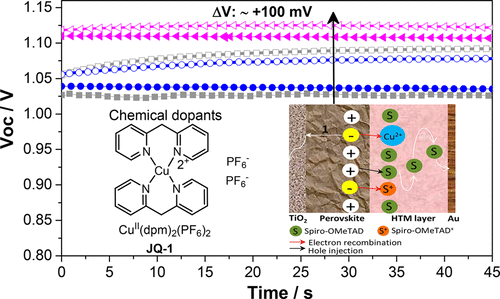Our official English website, www.x-mol.net, welcomes your
feedback! (Note: you will need to create a separate account there.)
Chemical Dopant Engineering in Hole Transport Layers for Efficient Perovskite Solar Cells: Insight into the Interfacial Recombination
ACS Nano ( IF 15.8 ) Pub Date : 2018-09-12 00:00:00 , DOI: 10.1021/acsnano.8b06062 Jinbao Zhang , Quentin Daniel 1 , Tian Zhang , Xiaoming Wen 2 , Bo Xu 3 , Licheng Sun 1, 4 , Udo Bach 5, 6 , Yi-Bing Cheng 7
ACS Nano ( IF 15.8 ) Pub Date : 2018-09-12 00:00:00 , DOI: 10.1021/acsnano.8b06062 Jinbao Zhang , Quentin Daniel 1 , Tian Zhang , Xiaoming Wen 2 , Bo Xu 3 , Licheng Sun 1, 4 , Udo Bach 5, 6 , Yi-Bing Cheng 7
Affiliation

|
Chemical doping of organic semiconductors has been recognized as an effective way to enhance the electrical conductivity. In perovskite solar cells (PSCs), various types of dopants have been developed for organic hole transport materials (HTMs); however, the knowledge of the basic requirements for being efficient dopants as well as the comprehensive roles of the dopants in PSCs has not been clearly revealed. Here, three copper-based complexes with controlled redox activities are applied as dopants in PSCs, and it is found that the oxidative reactivity of dopants presents substantial impacts on conductivity, charge dynamics, and solar cell performance. A significant improvement of open-circuit voltage (Voc) by more than 100 mV and an increase of power conversion efficiency from 13.2 to 19.3% have been achieved by tuning the doping level of the HTM. The observed large variation of Voc for three dopants reveals their different recombination kinetics at the perovskite/HTM interfaces and suggests a model of an interfacial recombination mechanism. We also suggest that the dopants in HTMs can also affect the charge recombination kinetics as well as the solar cell performance. Based on these findings, a strategy is proposed to physically passivate the electron–hole recombination by inserting an ultrathin Al2O3 insulating layer between the perovskite and the HTM. This strategy contributes a significant enhancement of the power conversion efficiency and environmental stability, indicating that dopant engineering is one crucial way to further improve the performance of PSCs.
中文翻译:

高效钙钛矿型太阳能电池的空穴传输层中的化学掺杂剂工程:界面重组研究
有机半导体的化学掺杂已被认为是增强电导率的有效方法。在钙钛矿太阳能电池(PSC)中,已经开发出各种类型的掺杂剂用于有机空穴传输材料(HTM)。但是,关于有效掺杂剂的基本要求以及掺杂剂在PSC中的全面作用的知识尚未清楚地揭示出来。在此,将三种具有受控氧化还原活性的铜基络合物用作PSC中的掺杂剂,发现掺杂剂的氧化反应性对电导率,电荷动力学和太阳能电池性能产生了重大影响。开路电压(V oc)的显着改善通过调整HTM的掺杂水平,可以使功率转换效率提高100%(超过100 mV),并将功率转换效率从13.2%提高到19.3%。观察到的三种掺杂物的V oc变化很大,揭示了它们在钙钛矿/ HTM界面处的重组动力学不同,并提出了一种界面重组机制的模型。我们还建议,HTM中的掺杂剂也会影响电荷复合动力学以及太阳能电池的性能。基于这些发现,提出了一种通过插入超薄Al 2 O 3来物理钝化电子-空穴复合的策略。钙钛矿和HTM之间的绝缘层。该策略有助于显着提高功率转换效率和环境稳定性,这表明掺杂剂工程技术是进一步提高PSC性能的一种关键方法。
更新日期:2018-09-12
中文翻译:

高效钙钛矿型太阳能电池的空穴传输层中的化学掺杂剂工程:界面重组研究
有机半导体的化学掺杂已被认为是增强电导率的有效方法。在钙钛矿太阳能电池(PSC)中,已经开发出各种类型的掺杂剂用于有机空穴传输材料(HTM)。但是,关于有效掺杂剂的基本要求以及掺杂剂在PSC中的全面作用的知识尚未清楚地揭示出来。在此,将三种具有受控氧化还原活性的铜基络合物用作PSC中的掺杂剂,发现掺杂剂的氧化反应性对电导率,电荷动力学和太阳能电池性能产生了重大影响。开路电压(V oc)的显着改善通过调整HTM的掺杂水平,可以使功率转换效率提高100%(超过100 mV),并将功率转换效率从13.2%提高到19.3%。观察到的三种掺杂物的V oc变化很大,揭示了它们在钙钛矿/ HTM界面处的重组动力学不同,并提出了一种界面重组机制的模型。我们还建议,HTM中的掺杂剂也会影响电荷复合动力学以及太阳能电池的性能。基于这些发现,提出了一种通过插入超薄Al 2 O 3来物理钝化电子-空穴复合的策略。钙钛矿和HTM之间的绝缘层。该策略有助于显着提高功率转换效率和环境稳定性,这表明掺杂剂工程技术是进一步提高PSC性能的一种关键方法。











































 京公网安备 11010802027423号
京公网安备 11010802027423号